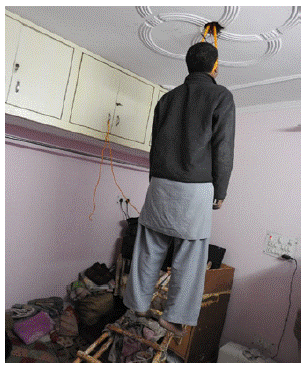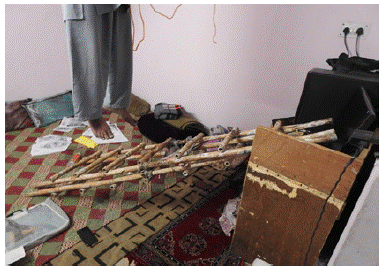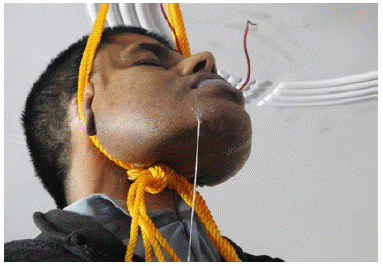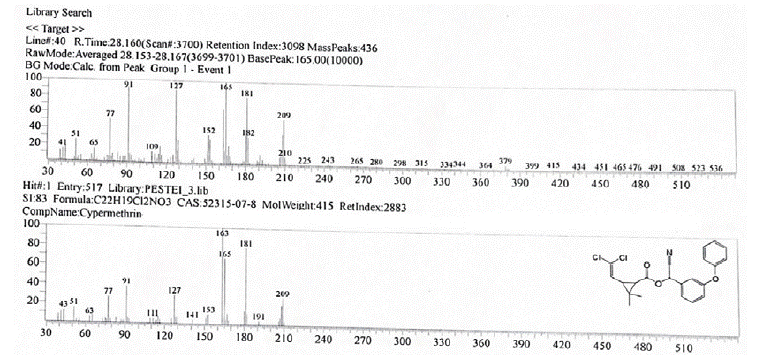
Case Report
Austin J Forensic Sci Criminol. 2022; 9(1): 1089.
Forensic Panorama of Complex Suicide Case Study from India
Saxena D, Sinha S*, Rai S and Tripathy S
Department of Chemistry Division, Forensic Science Laboratory, India
*Corresponding author: Sweta Sinha, Department of Chemistry Division, Forensic Science Laboratory, Sector 14, Rohini, Delhi, 110085, India
Received: September 01, 2022; Accepted: October 04, 2022; Published: October 11, 2022
Abstract
Complex suicides involve two separate method of self inflicted harm to take ones own life. Toxicological analysis of these medico-legal cases are encountered by the forensic analyst for chemical examination to ascertain cause of death. Statistical data for complex suicides is at present largely unrecorded though National Crime Records Bureau records suggest 53.6% by hanging followed by 25.8% deaths by poisoning in India. Compared to death by hanging, fatal cases due to pesticide intake with hanging are barely seen. Here in, we are reporting a rare case where the deceased had used this complex combination of suicide to terminate his life. A complete forensic investigation, including the scene of crime and autopsy examination, was observed wherein 44-year-old man had hung himself at his residence. Chemical examination to ascertain presence of any poison in visceral tissues to rule out intoxication was conducted. The chemical tests, Thin Layer Chromatography analysis, ATRFTIR and GC-MS instrumental analysis established the presence of pesticides (Organophosphorus and Pyrethroid) in his visceral organs. The cause of death as stated by the medical expert was anti-mortem hanging, but after detection of massive amount of pesticides in visceral tissues and post mortem blood, suggests ingestion of pesticides as well as asphyxia that led to the death of the deceased. Thus, the method of death was more toward planned complex definite suicide which is alarming and needs severe attention from various sections of society.
Keywords: Complex suicide; Hanging; Pesticides; Forensic; GC-MS; ATRFTIR; Organo-phosphorus and Pyrethroid
Introduction
Suicide is a major public health issue globally that falls under causes of death among the non-communicable disease category [1], where hanging is one of the most common unnatural deaths. The probable reason anticipated is certain, rapid, simple and painless death with easy and quick accessibility of required materials [2]. In India, as per National Crime Records Bureau (NCRB) data, 53.6 % of total cases of suicide committed resort to hanging as the first option [3,4]. However 77% of global suicide deaths mainly dominated in low and middle-income countries are with ingestion of pesticide, hanging and use of firearm [5,6]. Internationally, plenty of literature is available regarding trends of suicide by hanging [7,8] where investigations revealed more than 90% of cases had selected daily used items at home for the purpose [9]. Sometimes, the decision to commit suicide is well planned out extensively rather than being impulsive manoeuvring multiple methods know as ‘complex suicide’ [10-15]. In these circumstances individual ensures negligible survival by subjecting oneself to different modes of suicide to effectively end life. Thus, to warrant complete death the persons involve other methods like ingestion of toxic substance, drug overdose and drink excessive amount of alcohol probably to reduce pain, if any [16]. Lethal poisons found in household is conveniently exploited for this purpose due to its easy availability, carelessness about storage and their property to cause harm [17]. Pesticide being one of such poison, nonetheless, India, has prevalence of pesticide poisoning cases [18- 20] unintentional and intentional both [21,22]. The hazardous nature of pesticide has therefore caused additional liability on the morbidity and mortality data of our country as well on health statistical data of world [23-25].
Courage to instigate suicidal act, fear of potential attempt failure and its repurcurssions forces individuals to implement such complex methods to certain complete painless death. Investigation under such complexity of circumstances is challenging for forensic analyst and others like Scene Of Crime (SOC) investigator, medical officer where each of their roles in determining the cause of death cannot be underestimated. This study of complex suicide focuses on a detection of pesticides in visceral tissues, detailed SOC examination and medicolegal aspects of hanging as found by doctors to prove that the person had ensured his death without fail in his suicidal attempt. As suicides are globally prevalent and attempts to control are challenging for many, this motivated the authors to pen this case study for the advantage of society as well as to medical, judicial, police and forensic fraternity all working for common cause of social well being.
Scene of Crime Investigation
A 44-year-old man hung himself with the nylon rope fixed with the hook of the ceiling in his room (Figure 1). The hanging was complete-with double circle around his neck, and feet about 3 ft above from the floor. The deceased used the wooden ladder to reach the ceiling hook to tie one end (Figure 2). From the left corner of the mouth, was white frothy stripe of saliva dripping in downward direction as could be seen in (Figure 3). The whole room was in an uneven and scattered condition where, a hand written letter was found, in which the man communicated his intention to commit suicide (Figure 4). Investigating officer informed about his mental disturbance due to some alleged pestering from his own sister. It is important to mention here that the door was locked from inside when investigation agencies reached. Police and family found no evidence of suspected foul play.

Figure 1: Deceased as found hanging.

Figure 2: Distance from floor.

Figure 3: White frothy saliva strip.

Figure 4: Scattered Room.
Autopsy Finding
Eyes were closed with tongue caught between the teeth. Reddish brown imprint of ligature mark direct upwards and backward obliquely at the level above thyroid cartilage with no fracture of the hyoid bone and thyroid cartilage. Brain was found congested. Right Heart chamber was found full of fluid and clotted blood and left chamber was found empty. Stomach and portions of intestine had some greenish color fluid with peculiar smell. Congestion and oedematous condition was observed in stomach, liver, spleen and kidney.
Methodology
The case was received in sealed condition at Forensic Science Laboratory, Delhi to rule out any intoxication and poisoning. Basic screening was carried out as per our laboratory protocol. Post mortem blood, stomach, intestine, liver, spleen and kidney samples were extracted for chemical analysis and then Thin Layer Chromatography (TLC) was carried out. Further, the samples were analysed using Gas Chromatography Mass Spectrophotometry (GC-MS) and Attenuated total reflectance- Fourier transform infrared spectroscopy (ATRFTIR) instrument for confirmation of results.
Material and Method
Materials Required
Acetone, Hexane, palladium chloride, dil HCl, silver nitrate and Anhydrous Sodium sulphate used were of Analytical Grade (AR) purchased from Merck. Working standard of chlorpyriphos and cypermethrin was used for analysis in TLC. All glassware used were from Borosil. Silica gel TLC plates from Merck.
Sample Preparation
All viserceral samples were homogenised using a tissue homogeniser. Solvents Hexane and Acetone was added to the samples in ratio 1:1 and kept overnight. The solvent was filtered next through anhydrous sodium sulphate to remove water content and the clear filtered sample obtained was used for further analysis.
Thin Layer Chromatography
TLC was performed on a 20 cm × 10 cm TLC plates (silica gel G 60 F254) in TLC glass chamber filled with mobile phase Hexane: Acetone (8:2) to a depth of about 1cm and chamber saturated for 30 minutes. Purified extracts were serially spotted in the horizontal line on seperate TLC plates along with the working standards Chlorpyrifos (Organo-Phosphorus) and Cypermethrin (Pyrethroid) and run. The plates were removed from the chamber and visualized under UV light (254 nm) for characteristics fluorescence or absorbance. The developed plates were sprayed with spraying reagent (Palladium chloride for Chlorpyrifos and Silver nitrate for Cypermethrin) and colour of the spot observed with reference standard and the Rentention factor values for each spot was calculated [26].
ATR-FTIR-Analysis
ATR-FTIR spectrometer model No Alpha II (Bruker, Germany) was used for analysis of samples. Spectral measurements were acquired in continuous scan mode for 64 scans over range 600 to 4000 cm-1 at 4 cm-1 resolution. Samples are placed directly on the diamond crystal plate using pippette and images obtained through Infrared Focal Plane Array (FPA) detector. Spectra was processed using OPUS (from bruker) software for performing data analysis operations. Background measurements were carried before each sample.
GC-MS Analysis
Agilent 6890N GC with Mass Detector 5975 and autosampler 7683 B was used to analyse all the exhibits. The setting of the instrument is as described: Column- DB-5MS (30m x 0.250mm x 0.25μ). Oven Temperature started from 100°C for 1.5 min then at the rate of 7°C/ min till 300°C for 10 min, Injection Temp-280°C, Injection volume - 1μL, Mode – Split, Carrier Gas – Helium, Flow Rate – 70.9 ml/min., MSD parameters included EI tune type, temperature of MS source – 300°C, temperature of MS Quad- 150°C, scan range from mass- 29.00 to 400. Total run time for a cycle was 25 min. The samples were analysed by chemstation software and readings were compared with the NIST library Version 11.2.
Results
TLC is a cheap, convienteint and easily accessible chromatographic technique for preliminary identification of pesticides carried out in most of the chemical laboratories [27]. Seperated spots of tissues of Stomach and intestine, liver, spleen, kidney and PM blood were observed and Retention factor values were calculated and tallied with standard ‘Chlorpyrifos’ and ‘Cypermethrin’ shown in (Table 1). Spray reagents used were Palladium chloride and silver nitrate for ‘Chlorpyrifos’ and ‘Cypermethrin’ respectively to signify presence of pesticides in visceral tissues and PM blood. The IR spectrum was obtained by scanning it in the range 600 to 4000 cm-1 which confirms the presence of chlorpyrifos and cypermethrin in samples by characteristics peaks with wave number 2925, 2854, 1741, 1547, 1409, 1338, 1273, 1238, 1162, 1086, 1019, 962, 831, 748, 713, 693, 676, 652, 634 cm-1 for chlorpyrifos and 2956, 2923, 2856, 1745, 1608, 1587, 1488, 1455, 1378, 1247, 1125, 1076, 920, 879, 835, 806, 782, 696 cm-1 for cypermthrin.

Figure 5: FTIR-ATR chromatogram of chlorpyrifos.

Figure 6: FTIR-ATR chromatogram of cypermethrin.
S. No.
Exhibits
Chlorpyrifos
Cypermethrin
Distance travelled by solvent
Distance travelled by solute
Rf value
Distance travelled by solvent
Distance travelled by solute
Rf value
1
Stomach and Intestine
9
8.5
0.94
8
6.5
0.81
2
Liver, Spleen and Kidney
9
8.5
0.94
8
6.5
0.81
3
Stomach and Intestine
9
8.5
0.94
8
6.5
0.81
Table 1: TLC – Result.
All post mortem samples were further analysed by GC-MS and results has been shown in (Figure 7, 8, 9). GC-MS analysis of blood and visceral tissue sample showed TIC peaks at RT 15.72 having mass spectrum m/z values 97, 197, 349.0 of Chlorpyrifos and RT 27.81 m/z values 163, 209, 415 of Cypermethrin [28].

Figure 7: GC-MS Chromatogram of sample analysed.

Figure 8: Mass spectra of Chlorpyriphos peak at retention time of 15.72 min.

Figure 9: Mass spectra of Cypermethrin peak at retention time of 27.81 min.
Discussion
Complex suicide cases are complicated to interpret. The accurate evaluation is highly dependent on crime scene examination, medico legal autopsy and chemical analysis. In present study also, it is important to underline that the incident of crime was strongly supported by toxicological analysis for precise interpretation. (Table 1) denotes presence of pesticides in visceral tissues while screening during toxicological anlysis as per laboratory protocol. Furthermore, the detection of two different groups of pesticide by different analytical methods in visceral tissues and post mortem blood undoubtedly indicates the ingestion of poison. Cypermethrin falls under synthetic pyretheroid group disrupting sodium channel function while Chlorpyrifos is an organophosphate pesticide act as neuorotoxic poison when exposed to. The white frothy salivary materials dripping from the mouth of the deceased is one of the major symptom of pesticide poisoning [26]. The method of death in this case was more towards conscious planned complex suicide with recovery of suicide note as material evidence and door locked from inside as circumstantial evidence observed during crime scene investigation. Various combinations of complex suicide has been reported globally covering approximately 1-5% of all suicide cases in forensic autopsies [14]. Literature exists for simultaneous determination of cyperthrin and chlorpyrifos by different instrumental techniques GC-MS and ATR-FTIR showing high suitability of these techniques when employed to carry out chemical analysis [29-34], but their detection of poison in single cases along with asphyxia due to hanging is rare. GC-MS, considered as golden technique in forensic analysis, was used for detection of Chlorpyrifos and cypermethrin in the visceral tissues (Figure 7, 8, 9) whereas ATR-FTIR is also best technique for chemical identification (Figure 5, 6). This imaging technique is widely used due to its efficiency in spectral measurement where images provide clear representation of samples’s chemical composition. Commercial formulations in India has various individual concentration of chlorpyrifos and cypermethrin but when both pesticides are coformulated, the concentration of chlorpyrifos and cypermethrin was 50% and 5% approximately [35-37].
It is pertinent to mention therefore that complex cases of suicide are challenging from forensic investigation point of view. Hanging and self poisoning by insecticide especially organophosphorus group pesticide is most common method used for suicide as observed worldwide [38]. Minute observation at SOC and careful collection of evidence is an important part of forensic investigation. Salivary swab of liquid dripping from mouth of the deceased must have also been sent for chemical analysis under these circumstances to strengthen complete investigation. Therefore, vigilent examination to rule out increased likelihood of doubts raised as homicide or suicide or complex suicide is mandatory as the results are valuable evidence in cout of law and sometimes needs expert testimonial support too. There is insufficient government statistical data globally including Indian subcontinent wherein two entirely different method was adopted to avoid any possible potential risk of survival during the act. Though some efforts have been made by individual authors in international arena but due to lack of any government initiative, there is a large void [6-11]. Pesticide information centres will be helpful as no separate data for pesticide poisoning is collected by NCRB or any other agencies in India [39]. This will also be help to policy makers and regulators for better action as they can have improved statistical data regarding the trend of suicide with different parameters and implement measures and execute them. Roberts et al illustrates how srilankan regulatory bodies enabled to control suicide attempts from pesticide poisoning in positive manner [40]. Thus, it is sure to say that complex suicide is a growing public health problem globally and needs sufficient attention from governments and society at large.
Conclusion
Incidences of complex suicide where the deceased resort to planned multiple potential lethal methods to end his own life is a challenging investigation to deal with as they can be mistaken for homicide. Hanging with pesticide poisoning in the mentioned case proved to be a tough challenge with comprehensive SOC examination and thorough chemical examination for complete investigation. The important role of toxicological analysis could not be underestimated in these cases as only chemical analysis can unveil the presence of toxic pesticide in visceral tissues or else the case would have been concluded as asphyxial death only. Thus, a detailed investigation from diverse perspective becomes mandatory to find out the exact cause of death. This unique case of suicide highlights the responsibility of various stake holders to strictly monitor and regulate highly hazardous pesticides and also needs attention from the medical community, police, agriculture departments, and other regulatory authorities. The role of forensic scientist is of utmost importance particularly scene of crime examination and chemical analysis to provide quality information about the crime committed.
References
- World Health Organization, Regional Office for South-East Asia. Suicide prevention: emerging from darkness-celebrate life. WHO Regional Office forSouth-East Asia, New Delhi. 2001. http://www.who.int/iris/ handle/10665/205957.
- Biddle L, Donovan J, Owen-Smith A, Potokar J, Longson D, Hawton K, et al. Factors influencing the decision to use hanging as a method of suicide: qualitative study. British Journal of Psychiatry. 2010; 197: 320-325.
- National Crime Records Bureau.
- Hanging the first option for killing self, National Crime Records Bureau.
- Ajdacic-Gross V, Weiss MG, Ring M, Hepp U, Bopp M, Gutzwiller F, et al. Methods of suicide: international suicide patterns derived from the WHO mortality database. Bulletin of the World Health Organization. 2008; 86: 726- 732.
- International association of suicide prevention.
- Hunter E, Harvey D. Indigenous suicide in Australia, New Zealand, Canada and the United States. Emergency Medicine Australasia. 2002; 14: 14–23.
- Graham A, Reser J, Scuderi C, Zubrick S, Smith M, Turley B. Suicide: An Australian Psychological Society Discussion Paper. Australian Psychologist. 2000; 35: 1–28.
- Bennewith O, Gunnell D, Kapur N, Turnbull P, Simkin S, Sutton L, et al. Suicide by hanging: multicentre study based on coroners’ records in England. British Journal of Psychiatry. 2005; 186: 260-261.
- Demirci S, Dogan KH, Erkol Z, Deniz . A Series of Complex Suicide. The American Journal of Forensic Medicine and Pathology. 2009; 30: 152-154.
- Hösükler E, Hösükler B, Çoban İ, Koc S. Complex suicides: 21 cases and a review of the literature. Egypt J Forensic Sci. 2022; 12: 10.
- Vidhate SG, Pathak H, Parchake M, Sukhadeve R, Meshram V A planned complex suicide: Cut injury to the wrist with corrosive acid poisoning. Egypt Journal Forensic Sci. 2016; 6: 478–480.
- Racette S, Sauvageau A. Planned and Unplanned Complex Suicides: A 5-year Retrospective Study. Journal of Forensic Sciences. 2007; 52: 449- 452.
- Ateriya N, Kanchan T, Shekhawat RS, Setia P, Saraf A. Unplanned Complex Suicide—A Consideration of Multiple Methods. Journal of Forensic Sciences. 2018; 63: 945-946.
- Viel G, Schröder AS, Püschel K, Braun C. Planned complex suicide by penetrating captive-bolt gunshot and hanging: case study and review of the literature. Forensic science international. 2009; 187: e7-e11.
- Ferrari AJ, Norman RE, Freedman G, Baxter AJ, Pirkis JE, Harris MG, et al. The Burden Attributable to Mental and Substance Use Disorders as Risk Factors for Suicide: Findings from the Global Burden of Disease Study 2010. PLoS ONE. 2014; 9: e91936.
- Sinha S, Kumar A, Goyal K. Chemical signature of house hold cleaning products to unveil crime –forensic evaluation of case study. J of Forensic, Legal and Investigative Science. 2022.
- Idiz N, Karakus A, Dalgıç M. The Forensic Deaths Caused by Pesticide Poisoning Between the Years 2006 and 2009 in Izmir, Turkey *. Journal of Forensic Sciences. 2012; 57: 1014-1016.
- Pesticides leading cause of poisoning in India.
- Karunarathne A, Bhalla A, Sethi A, Perera U, Eddleston M. Importance of pesticides for lethal poisoning in India during 1999 to 2018: a systematic review. BMC Public Health. 2021; 21: 1441.
- Boedeker W, Watts M, Clausing P, Marquez E. The global distribution of acute unintentional pesticide poisoning: estimations based on a systematic review. BMC Public Health. 2020; 20: 1875.
- Mittal C, Singh S, Kumar-M P, Varthya SB. Toxicoepidemiology of poisoning exhibited in Indian population from 2010 to 2020: a systematic review and meta-analysis. BMJ Open. 2021; 11: e045182.
- Srivastava A, Peshin SS, Kaleekal T, Gupta SK. An epidemiological study of poisoning cases reported to the National Poisons Information Centre, All India Institute of Medical Sciences, New Delhi. Human and Experimental Toxicology. 2005; 24: 279-285.
- Gunnell D, Eddleston M, Phillips MR, Konradsen F. The global distribution of fatal pesticide self-poisoning: Systematic review. BMC Public Health. 2007; 7: 357-357.
- Mew EJ, Padmanathan P, Konradsen F, Eddleston M, Chang S, Phillips MR, et al. The global burden of fatal self-poisoning with pesticides 2006-15: Systematic review. Journal of affective disorders. 2017; 219: 93-104.
- Jaiswal A K, Millo T. Handbook of forensic analytical toxicology, Jaypee brothers medical publishers (P) ltd.; 2014
- Ambrus A, Füzesi I, Susán M, Dobi D, Lantos J, Zakar F, et al. A Cost-Effective Screening Method for Pesticide Residue Analysis in Fruits, Vegetables, and Cereal Grains. Journal of Environmental Science and Health, Part B. 2005; 40: 297-339.
- Moffat A C, Osselton M D, Widdop B, Watts J. Clarke’s Analysis fo drugs and Poisons, Pharmaceutical press, 4th revised edition, 2011.
- Matthew J. Almond and Stephen J. Knowles. Quantitative Analysis of Agrochemical Formulations by Multivariate Spectroscopic Techniques. Appl. Spectrosc. 1999; 53: 1128-1137.
- Sharma KK, Gupta S, Handa SK. Fourier transform infrared spectroscopic determination of cypermethrin and deltamethrin in emulsifiable concentrate formulations. Talanta. 1997; 44: 2075-2079.
- Bunaciu A, Abou-Enein HY, Fleschin S: Application of Fourier Transform Infrared Spectrophotometry in Pharmaceutical Drugs Analysis. Appl Spectrosc Rev. 2010; 45: 206–219.
- Armenta S, Quintás G, Garrigues S, Guardia MDL. A validated and fast procedure for FTIR determination of Cypermethrin and Chlorpyrifos. Talanta. 2005; 67: 634-639.
- Soares S, Rosado T, Barroso M, Vieira DN, Gallardo E. Organophosphorus pesticide determination in biological specimens: bioanalytical and toxicological aspects. International Journal of Legal Medicine. 2019; 133: 1763-1784.
- Kavvalakis MP, Tzatzarakis MN, Alegakis AK, Vynias D, Tsakalof AK, Tsatsakis AM. Development and application of GC-MS method for monitoring of long-term exposure to the pesticide cypermethrin. Drug testing and analysis. 2014; 6: 9-16.
- List of Insecticides, assam government, Types of pesticides and uses.
- Agro-chemical technical with brand name, application, dose and mode of action.
- Indian Council of Agricultural Research -National Research Centre on pomegranate.
- RANE A, NADKARNI A. Suicide in India: a systematic review. Shanghai Archives of Psychiatry. 2014; 26: 69-80.
- Pagdhune A, Kunal K, Patel K A, Patel A B, Mishra S, Palkhade R, Muhamed J. Poisoning Cases Reported to Poison Information Centre, Ahmedabad, India: A Three Year Observational Study. Central Asian Journal of Global Health. 2020: 9.
- Knipe DW, Gunnell D, Eddleston M. Preventing deaths from pesticide selfpoisoning- learning from Sri Lanka’s success. The Lancet. Global health. 2017; 5: e651-e652.